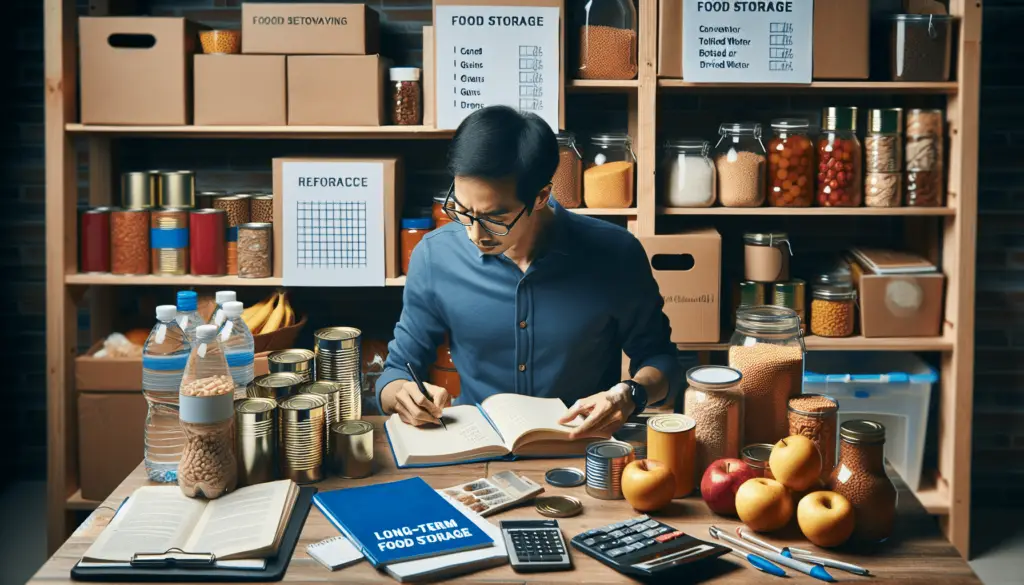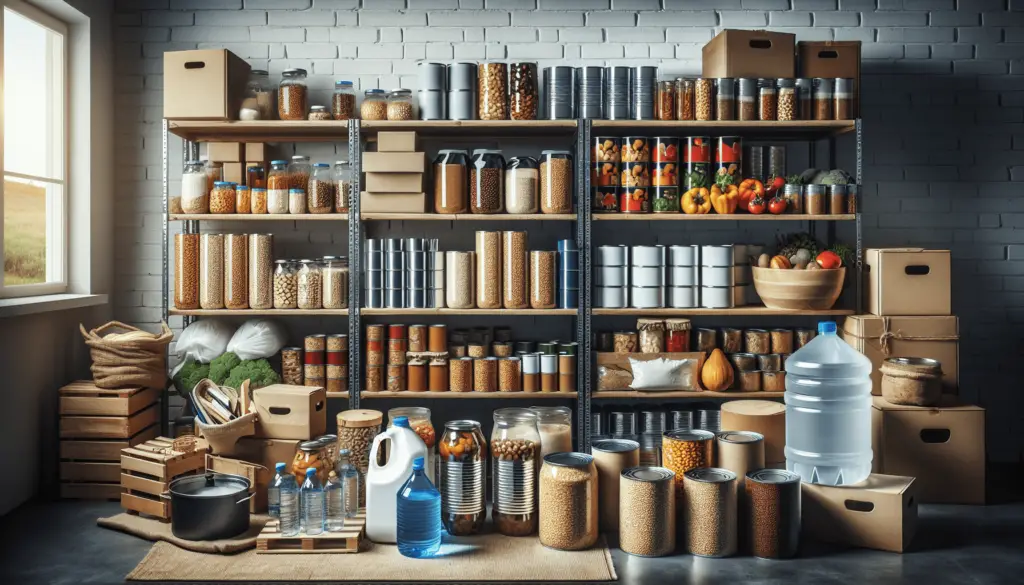Are you prepared for unexpected emergencies? Building an emergency food supply is crucial to ensure you and your loved ones have enough food during times of crisis. In this article, we will explore practical tips and guidelines to help you begin building your emergency food supply. Whether you are a beginner or simply looking to enhance your existing provisions, these insights will provide you with the knowledge and tools to be well-prepared for any unforeseen circumstances.

Assess Your Needs
Determine the Duration
The first step in building your emergency food supply is to assess how long you need to prepare for. Consider potential emergencies such as natural disasters, power outages, or financial hardships, and estimate how many days or weeks you would need to sustain yourself and your family. The duration will help you determine the quantity of food and water you should stock up on.
Consider Dietary Restrictions
Next, consider any dietary restrictions you or your family members may have. Take into account any allergies, intolerances, or specific dietary choices such as vegetarian or vegan. Ensure that the food you choose to include in your emergency supply meets these requirements, or have alternative options available.
Calculate the Caloric Requirements
To ensure you have enough food to sustain yourself during emergencies, it’s important to calculate your daily caloric requirements. The average adult requires around 2000-2500 calories per day, but this can vary depending on age, gender, and activity level. Multiply your average daily calories by the estimated duration of your emergency to determine how many calories you should aim to have in your food supply.
Create a Plan
Set a Budget
Before diving into building your emergency food supply, it’s important to set a budget. Determine how much you are able and willing to spend on your food storage, considering other necessary expenses such as bills and medical costs. Having a budget in place will help you make informed decisions when purchasing food items.
Decide on Storage Space
Consider the available storage space in your home when planning your food supply. If you have limited space, you may need to get creative with storage solutions such as utilizing underutilized areas or investing in space-saving containers. Ensure that your chosen storage area is cool, dry, and away from direct sunlight to maximize the shelf life of your stored items.
Create a Shopping List
Based on your assessment of needs and budget, create a comprehensive shopping list for your emergency food supply. Include a variety of food items from different food groups to ensure a balanced diet during emergencies. Consider both ready-to-eat items and ingredients that can be used to prepare meals. It’s always a good idea to include some comfort foods to boost morale during challenging times.
Choose Nutritious Foods
Include a Variety of Food Groups
A well-rounded emergency food supply should include a variety of food groups. Aim to include grains, proteins, fruits, vegetables, and dairy (including non-dairy alternatives). This will ensure that you have a good balance of nutrients, vitamins, and minerals to support your health during emergencies. Consider both canned and dried options, as well as freeze-dried or dehydrated goods for longer shelf life.
Opt for Shelf-Stable and Non-Perishable Items
When choosing food items for your emergency supply, prioritize shelf-stable and non-perishable options. These include canned goods, dried fruits and vegetables, rice, pasta, and beans. These items have a longer shelf life and are less likely to spoil or require refrigeration. Opting for such items will help you minimize food waste and ensure that your supply is always viable.
Prioritize Foods with Long Shelf Life
To extend the shelf life of your emergency food supply, prioritize items that have a naturally long shelf life. Examples include whole grains, honey, powdered milk, dried beans, and canned meat or fish. These items can last for months to years when stored properly, providing you with sustenance during prolonged emergencies. Remember to rotate your stock periodically to maintain freshness.

Stock Up on Staples
Grains and Cereals
Grains and cereals are essential staples in any emergency food supply. Stock up on items such as rice, pasta, oats, and flour to ensure a good source of carbohydrates for energy. Consider storing these items in airtight containers to prevent moisture and pests from compromising their shelf life.
Proteins and Legumes
Proteins are crucial for maintaining muscle strength and overall health during emergencies. Include canned meats (such as tuna or chicken), dried beans, lentils, and peanut butter in your stock. These can provide you with essential nutrients and variety in your meals.
Fruits and Vegetables
While fresh fruits and vegetables may not be viable for long-term storage, there are alternatives to ensure you still get the necessary vitamins and minerals. Opt for dried fruits and vegetables, as well as canned options that have been preserved without added sugars or sodium. These can add flavor, texture, and nutrition to meals during emergencies.
Store Water
Determine Water Needs
In addition to food, water is a vital component of any emergency supply. Calculate how much water you and your family would need for drinking, cooking, and sanitation purposes. The general guideline is to have at least one gallon of water per person per day for a minimum of three days. Adjust this based on your specific needs and climate.
Choose Suitable Containers
When storing water, it’s important to choose suitable containers that are safe and durable. Opt for food-grade plastic containers, glass bottles, or water storage drums specifically designed for long-term water storage. These containers should be thoroughly cleaned, sanitized, and tightly sealed to prevent contamination.
Learn Water Purification Methods
In addition to storing water, it’s essential to learn various water purification methods. This knowledge can be invaluable in situations where fresh water sources may become compromised. Research and educate yourself on purification techniques such as boiling, using water purification tablets, or investing in a portable water filter.
Rotate and Maintain Your Stock
Adhere to First In, First Out (FIFO) System
To ensure the freshness and effectiveness of your emergency food supply, practice the first in, first out (FIFO) system. Always use the oldest food items first and replace them with new ones. This rotation will prevent items from expiring or becoming unusable before you have the chance to consume them.
Inspect and Discard Expired Items
Regularly inspect your food stock for any expired items or signs of spoilage. Discard any food that has passed its expiration date, has a strange smell, or shows signs of mold or pests. Maintaining a clean and organized stock will help ensure the safety and quality of your emergency food supply.
Conduct Regular Inventory Checks
Perform regular inventory checks to keep track of your food supply. Make a habit of documenting the quantity and expiration dates of each item. This will help you monitor your stock levels and make informed decisions about replenishing essential items.
Consider Special Needs
Infant Formula and Baby Food
If you have infants or young children in your family, it’s important to consider their specific needs when building your emergency food supply. Stock up on an appropriate amount of infant formula, baby food, diapers, and other essential supplies to ensure their well-being during emergencies.
Pet Food and Supplies
Don’t forget about your furry family members! Include an ample supply of pet food, treats, and any necessary medications in your emergency storage. Consider their dietary needs and any specific requirements they may have. Additionally, stock up on essentials such as litter, bedding, and toys to keep them comfortable during uncertain times.
Medications and Medical Supplies
For individuals who rely on medications or have specific medical needs, it’s crucial to include an adequate supply of necessary medications in your emergency food supply. Consult with your healthcare provider to ensure you have the correct quantity and instructions for storage. Additionally, stock up on basic medical supplies such as bandages, antiseptics, and over-the-counter medications for common ailments.
Learn to Cook with Basic Ingredients
Acquire Simple and Versatile Recipes
In times of emergency, it’s useful to have a collection of simple and versatile recipes that can be prepared with basic ingredients. Look for recipes that require minimal preparation, cooking time, and specialized ingredients. This will ensure that you can create nutritious and satisfying meals even with limited resources.
Invest in Cooking Tools and Equipment
Prepare for emergencies by investing in cooking tools and equipment that can be used without electricity. This includes items such as a camping stove, portable grill, or solar-powered cooking devices. Having these alternative cooking methods will allow you to prepare meals even during power outages or other emergencies.
Practice Cooking without Electricity
To truly be prepared, practice cooking without electricity before an actual emergency occurs. Familiarize yourself with alternative cooking methods and test out various recipes using these methods. Being comfortable and confident in cooking without electricity will greatly benefit you during times when conventional cooking methods are not available.
Build a Pantry
Organize Food Storage Areas
Creating an organized food storage area is essential for maintaining an efficient emergency food supply. Dedicate a specific space in your home to store your food stock and ensure that it is clean, dry, and easily accessible. Use shelves, bins, and labels to keep your items organized and easily visible.
Label and Track Inventory
Label each food item with its name, expiration date, and quantity information. This will help you keep track of inventory and identify items that need to be rotated or replenished. Use a simple inventory system, either on paper or digitally, to monitor and track your stock effectively.
Maintain a List of Expiring Items
To minimize food waste, keep a list of items in your emergency food supply that are approaching their expiration dates. By staying vigilant and planning your meals accordingly, you can ensure that these items are used before they expire. Incorporate them into your cooking rotation or consider donating them to local food banks if appropriate.
Educate Yourself and Your Family
Learn First Aid and Emergency Preparedness
Alongside building an emergency food supply, it’s important to educate yourself and your family about first aid and emergency preparedness. Enroll in first aid and CPR courses to learn life-saving skills. Familiarize yourself with emergency procedures, evacuation plans, and the location of emergency shelters in your area. Being prepared and informed will help you stay calm and respond effectively during emergencies.
Discuss and Create an Emergency Plan
Gather your family members and discuss a comprehensive emergency plan. Include protocols for communication, meeting points, evacuation routes, and important contact information. Assign responsibilities to each family member and ensure everyone is aware of their role in the event of an emergency. Regularly review and update your plan as necessary.
Stay Informed about Potential Hazards
Stay informed about potential hazards and emergencies that may affect your area. Sign up for local emergency alerts and notifications to receive real-time information. Stay updated on weather forecasts, news reports, and advisories from local authorities. Being aware of potential risks will empower you to take necessary precautions and make informed decisions for the safety of you and your family.
By following these steps, you can confidently start building your emergency food supply. Remember to regularly review and update your stock, practice cooking without electricity, and stay informed about potential hazards. With careful planning and preparation, you can ensure the well-being of yourself and your loved ones during uncertain times.
